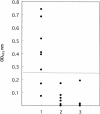Molecular cloning of a Babesia caballi gene encoding the 134-kilodalton protein and evaluation of its diagnostic potential in an enzyme-linked immunosorbent assay
- PMID: 14715570
- PMCID: PMC321337
- DOI: 10.1128/cdli.11.1.211-215.2004
Molecular cloning of a Babesia caballi gene encoding the 134-kilodalton protein and evaluation of its diagnostic potential in an enzyme-linked immunosorbent assay
Abstract
A Babesia caballi gene encoding the 134-kDa (BC134) protein was immunoscreened with B. caballi-infected horse serum. An enzyme-linked immunosorbent assay (ELISA) using recombinant BC134 protein could effectively differentiate B. caballi-infected horse sera from Babesia equi-infected or noninfected control horse sera. These results suggest that the recombinant BC134 protein is a potential diagnostic antigen in the detection of B. caballi infection.
Figures





Similar articles
-
Cloning and expression of a 48-kilodalton Babesia caballi merozoite rhoptry protein and potential use of the recombinant antigen in an enzyme-linked immunosorbent assay.J Clin Microbiol. 1999 Nov;37(11):3475-80. doi: 10.1128/JCM.37.11.3475-3480.1999. J Clin Microbiol. 1999. PMID: 10523537 Free PMC article.
-
Cloning of a truncated Babesia equi gene encoding an 82-kilodalton protein and its potential use in an enzyme-linked immunosorbent assay.J Clin Microbiol. 2002 Apr;40(4):1470-4. doi: 10.1128/JCM.40.4.1470-1474.2002. J Clin Microbiol. 2002. PMID: 11923375 Free PMC article.
-
Expression of Babesia equi merozoite antigen 1 in insect cells by recombinant baculovirus and evaluation of its diagnostic potential in an enzyme-linked immunosorbent assay.J Clin Microbiol. 2001 Feb;39(2):705-9. doi: 10.1128/JCM.39.2.705-709.2001. J Clin Microbiol. 2001. PMID: 11158131 Free PMC article.
-
Recently developed methods for the detection of babesial infections.Trans R Soc Trop Med Hyg. 1989;83 Suppl:21-3. doi: 10.1016/0035-9203(89)90598-1. Trans R Soc Trop Med Hyg. 1989. PMID: 2696156 Review.
-
Molecular variation and diversity in candidate vaccine antigens from Babesia.Acta Trop. 1993 May;53(3-4):227-38. doi: 10.1016/0001-706x(93)90031-6. Acta Trop. 1993. PMID: 8100672 Review.
Cited by
-
Development of a promising antigenic cocktail for the global detection of Babesia caballi in horse by ELISA.PLoS One. 2023 Apr 14;18(4):e0284535. doi: 10.1371/journal.pone.0284535. eCollection 2023. PLoS One. 2023. PMID: 37058508 Free PMC article.
-
Cloning of a novel Babesia equi gene encoding a 158-kilodalton protein useful for serological diagnosis.Clin Diagn Lab Immunol. 2005 Feb;12(2):334-8. doi: 10.1128/CDLI.12.2.334-338.2005. Clin Diagn Lab Immunol. 2005. PMID: 15699430 Free PMC article.
References
-
- Bashiruddin, J. D., C. Camma, and E. Revelo. 1999. Molecular detection of Babesia equi and Babesia caballi in horse blood by PCR amplification of part of the 16S rRNA gene. Vet. Parasitol. 84:75-83. - PubMed
-
- Böse, R., and B. Peymann. 1994. Diagnosis of Babesia caballi infections in horses by enzyme-linked immunosorbent assay (ELISA) and Western blot. Int. J. Parasitol. 24:341-346. - PubMed
-
- Brüning, A., P. Phipps, E. Posnett, and E. U. Canning. 1997. Monoclonal antibodies against Babesia caballi and Babesia equi and their application in serodiagnosis. Vet. Parasitol. 58:11-26. - PubMed
-
- Friedhoff, K. T. 1982. The piroplasms of equidae. Significance for the international equine trade. Berl. Muench. Tieraerztl. Wochenschr. 95:368-374. - PubMed
-
- Friedhoff, K. T., A. M. Tenter, and I. Müller. 1990. Haemoparasites of equines: impact on the international trade of horses. Rev. Sci. Technol. 9:1187-1194. - PubMed
Publication types
MeSH terms
Substances
Associated data
- Actions
LinkOut - more resources
Full Text Sources

